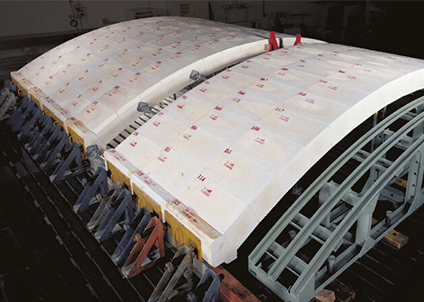High-strength and low-thermal conductivity bricks are a new type of refractory insulation material independently developed by our company.
Traditional solid bricks have high strength, but they have almost no insulation effect. Traditional lightweight bricks have good insulation effect, but low strength. High-strength and low-conductivity bricks combine the high strength of heavy bricks with insulation performance of lightweight bricks.
The application of high-strength and low-conductivity bricks in the insulation lining of rotary kilns, compared with the scheme of enhancing insulation effect by inlaying traditional insulation materials, does not reduce the insulation effect and the energy-saving effect is more stable and long-lasting.
This product can also be used for insulation in kilns with high strength requirements. Under conditions where it does not directly contact the melt, it can replace traditional heavy products, achieving long-term energy conservation and consumption reduction, and obtaining better economic returns.



| Item | Unit | ||||||
| BD | g/cm3 | 1.9±0.05 | 1.82±0.05 | 1.35±0.05 | 1.25±0.05 | 1.15±0.05 | |
| CCS | MPa | ≥40 | ≥45 | ≥35 | ≥20 | ≥15 | |
|
PLC |
1450℃×6h |
% |
– | ≤0.2 | – | – | – |
| 1300℃×6h | – | – | ≤0.5 | ≤0.5 | ≤0.5 | ||
| 1500℃×3h | ±0.5 | ||||||
| Thermal conductivity | Hot face 800℃ |
W/(m·K) |
≤0.38 | ≤0.45 | ≤0.5 | ≤0.42 | ≤0.35 |
| Hot face 1000℃ | ? | ≤0.5 | ≤0.55 | ≤0.47 | ≤0.4 | ||
| RUL | 0.2MPa×0.6% | ℃ | ≥1480 | ≥1450 | ≥1250 | ≥1200 | – |
| High temperature MOR | 1000℃ | MPa | ? | ≥18 | – | – | – |
| Thermal expansion | Room temperature ~800℃ |
% |
? | 0.39 | 0.46 | – | – |
| Room temperature~1000℃ | ? | 0.53 | 0.54 | – | – | ||
| Al2O3 | % | ≥55 | ≥50 | 21
21 |
|||
| Fe2O3 | % | ≤1 | ≤0.8 | 3
3 |
|||
| SiO2 | % | ? | ~42 | 70 | |||